Gum diseases
Gum diseases is actually infection of the gum and bone that surround and support the teeth. In its early stage, called gingivitis, where the gum is red, swollen, and bleed easily but little or no discomfort at this stage. Gingivitis is reversible. In its more serious form, periodontitis, the gums and bone that support the teeth are involved. Gums separate from the teeth, forming pockets (spaces between the teeth and gums) that become infected. As the disease progresses, the pockets deepen and more gum tissue and bone are destroyed. Eventually, teeth can become loose or even fall out.
Causes and risk factors for gum disease
Plaque which contains bacteria is the primary cause of gum disease. Certain risk factors can contribute to gum disease. These include:
- Smoking
- Diabetes
- Poor oral hygiene
- Stress
- Heredity
- Crooked teeth
- Underlying immuno-deficiencies – e.g., AIDS
- Fillings that have become defective
- Taking medications that cause dry mouth
- Bridges that no longer fit properly
- Female hormonal changes, such as with pregnancy or the use of oral contraceptives
Signs and Symptoms of Gum Disease
Signs and symptoms of the disease include:
- Red or swollen gums
- Bad breath or bad taste that won’t go away
- Tender or bleeding gums
- Sensitive teeth
- Painful chewing
- Loose teeth
- Gums that have pulled away from your teeth (recession).
- Any change in the way your teeth fit together when you bite (teeth migration)
- Any change in the fit of partial dentures
Many signs and symptoms mentioned above can affect the beautiful smile (aesthetic), and your teeth are one of the most visible parts of your face, especially when you are smiling.
Aesthetic dentistry
Aesthetic dentistry is where science and art combine in the practice of dentistry. It embraces all the dental disciplines with the aim of creating the best outcome for the patient, from an aesthetic, functional and biological perspective and very individualised. The dentist looks at your dental problem and provides the optimum solution for your dental health and function, whilst at the same time achieving a beautiful and natural appearance. The goal is to recreate how your teeth would be if you did not have dental problems and your teeth and gums were in ideal condition. This is not the same as cosmetic dentistry, which strictly speaking involves changing simply the appearance of your teeth.
Treatment options to improve dental aesthetic following periodontal disease
With the advancement of science and technology, the dentist is able to treat and eradicate periodontal disease as well as save a number of teeth, and with a carefully planned inter-disciplinary approach involving periodontal treatment, orthodontic treatment, and restorative treatment with dental implants and crowns and bridges the dentist is able to rebuild and regenerate the gum, bone and teeth.
Following are some of the procedures that dentist use to improve dental aesthetic of patient with periodontal disease:
- Periodontal surgery with soft tissue grafting.
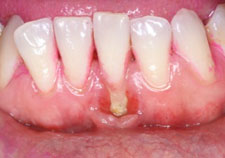
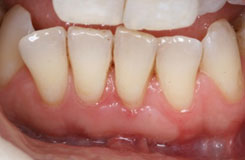
Soft Tissue Grafting is recommended when you have gum recession that has left the root of a tooth exposed, or you’re at risk of root exposure due to recession. Soft Tissue Grafting is a common procedure that is intended to recreate your gum line and prevent further deterioration of the gums, while enhancing the appearance of your smile.
- Orthodontics treatment to realign the teeth with orthodontic braces.
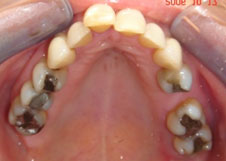
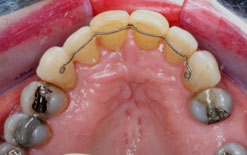
- Restorative treatment with crown, bridge and Implant to replace missing teeth.
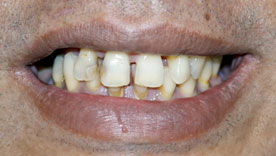
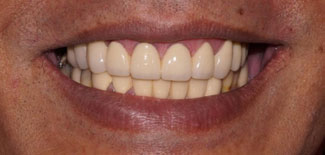
(courtesy Dr Yong Peng San) - Gum or gingival veneer (gingival mask) is a false gum used to replace a large volume of tissue that has been lost to the periodontal disease process or its treatment.
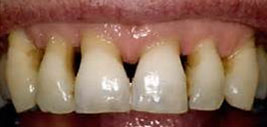

(courtesy gingivalmasks.com) - Denture
- Combination of all the above treatment
To help prevent or control periodontal diseases, it is important to:
- Brush and floss every day to remove the bacteria that cause gum disease.
- See a dentist at least once a year for check-up, or more frequently if you have any of the warning signs or risk factors mentioned above.
| Last Reviewed | : | 20 March 2015 |
| Writer | : | Dr. Eng Heng Ling |
| Accreditor | : | Dr. Chan Yoong Kian |
| Reviewer | : | Dr. Ahmad Sharifuddin bin Mohd Asari |







